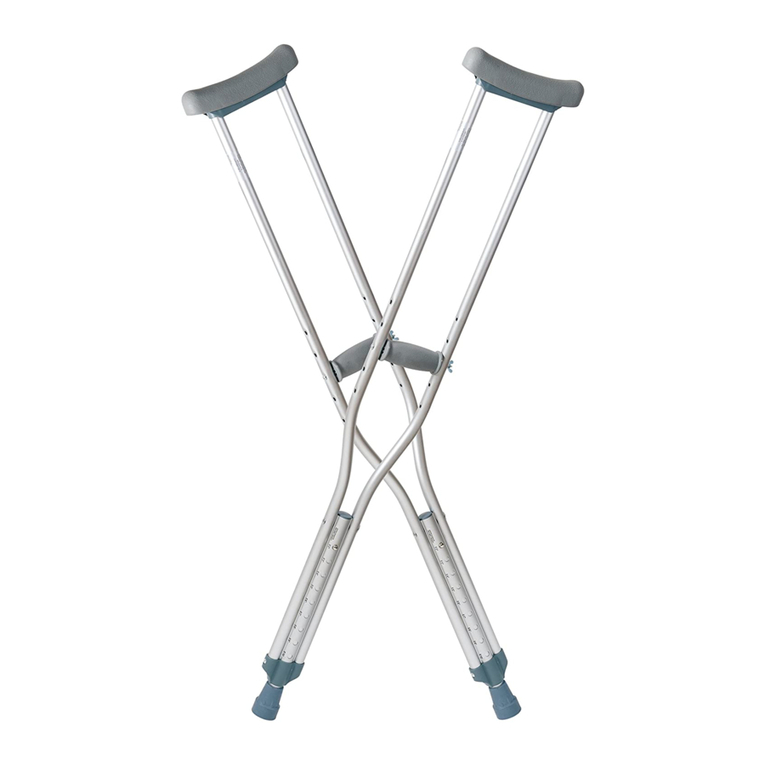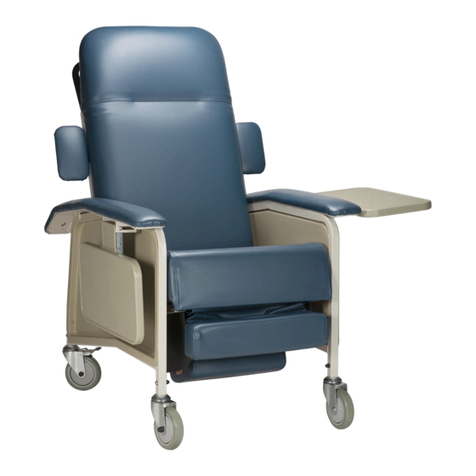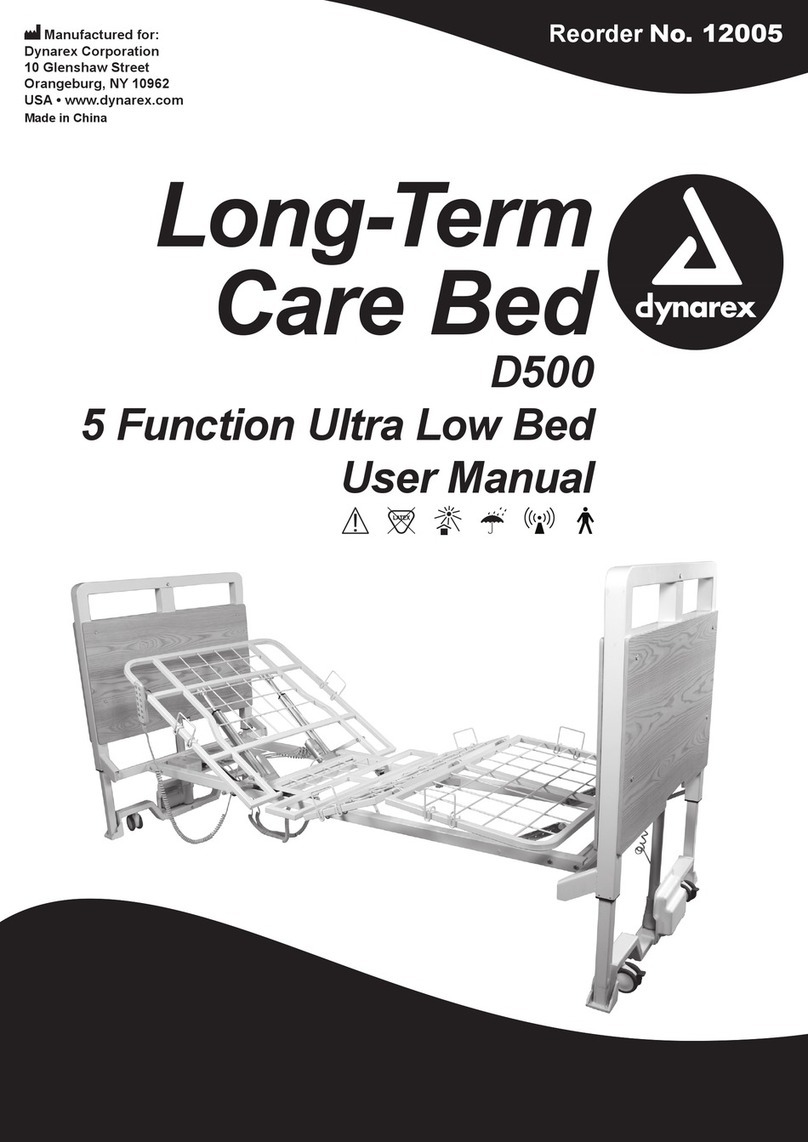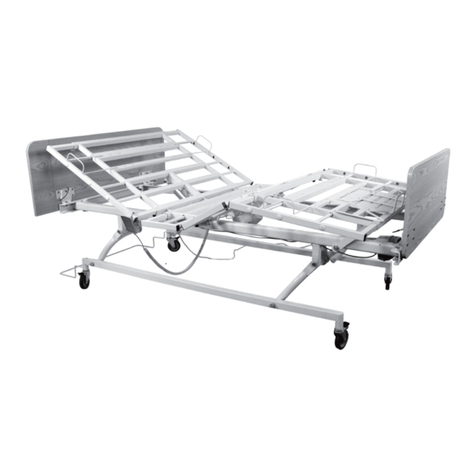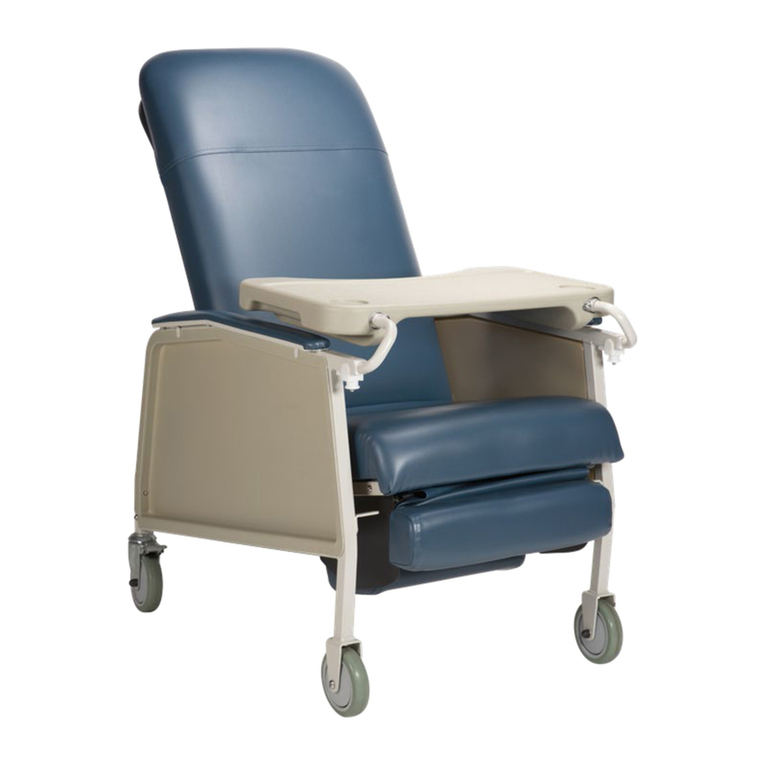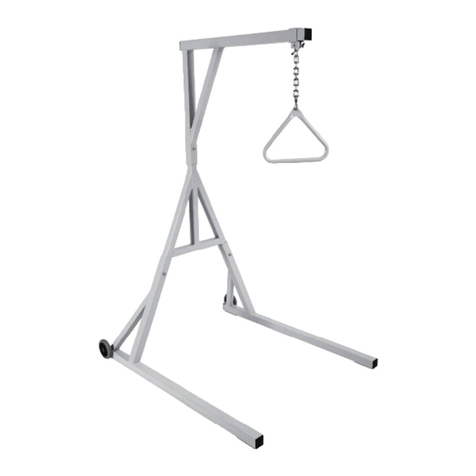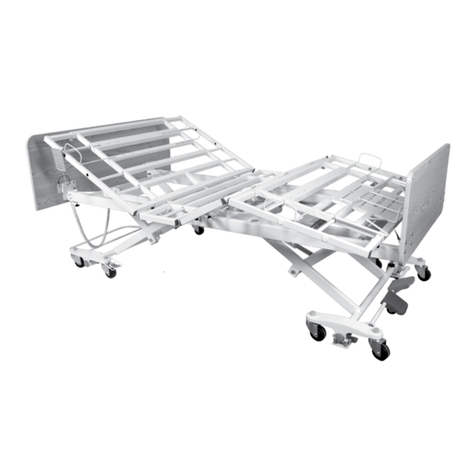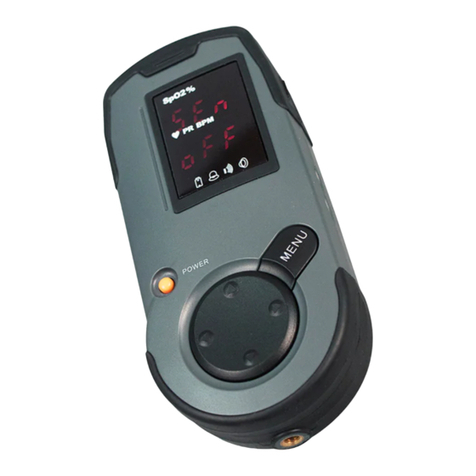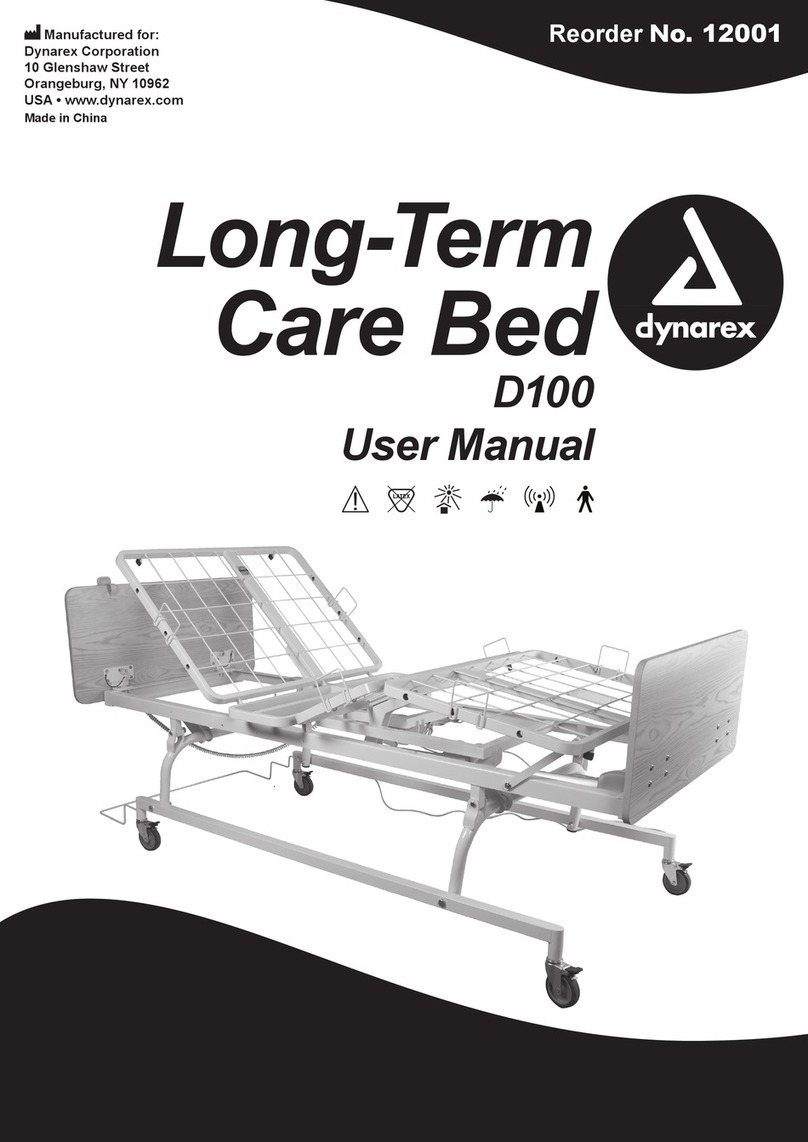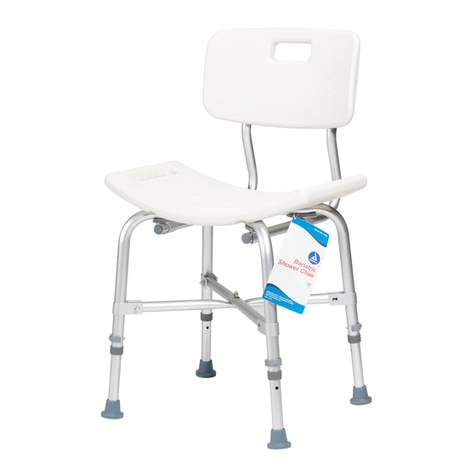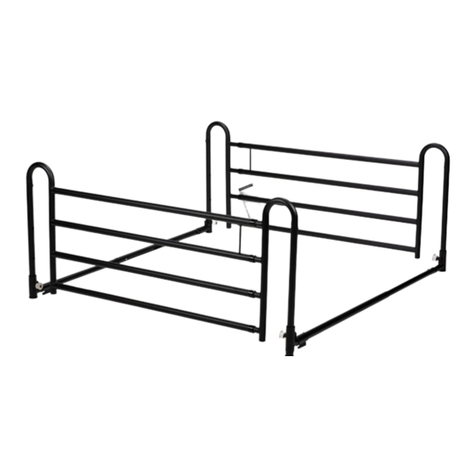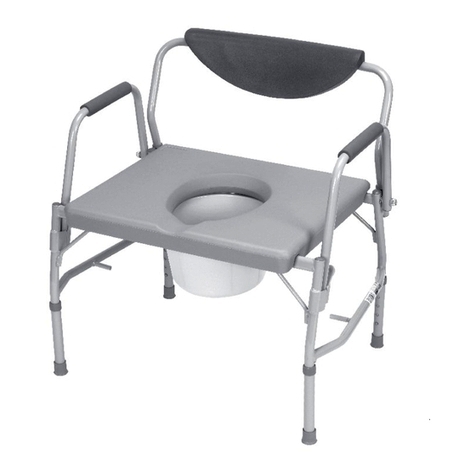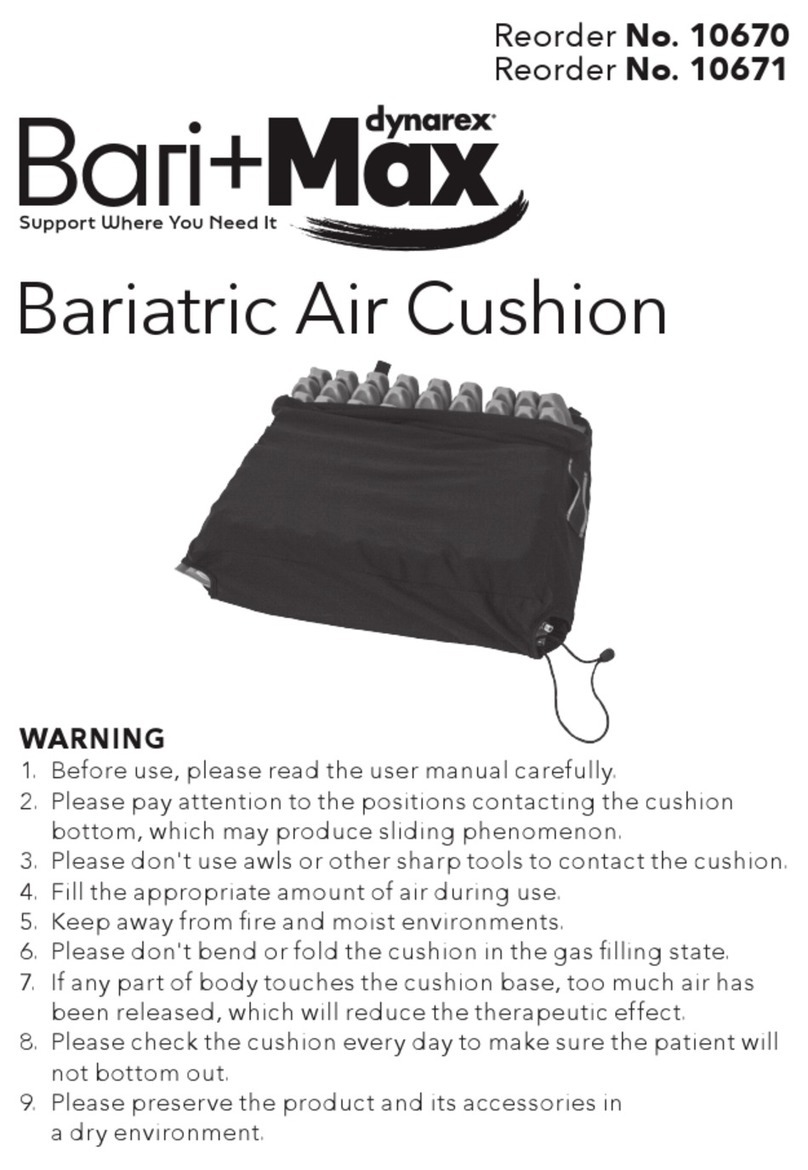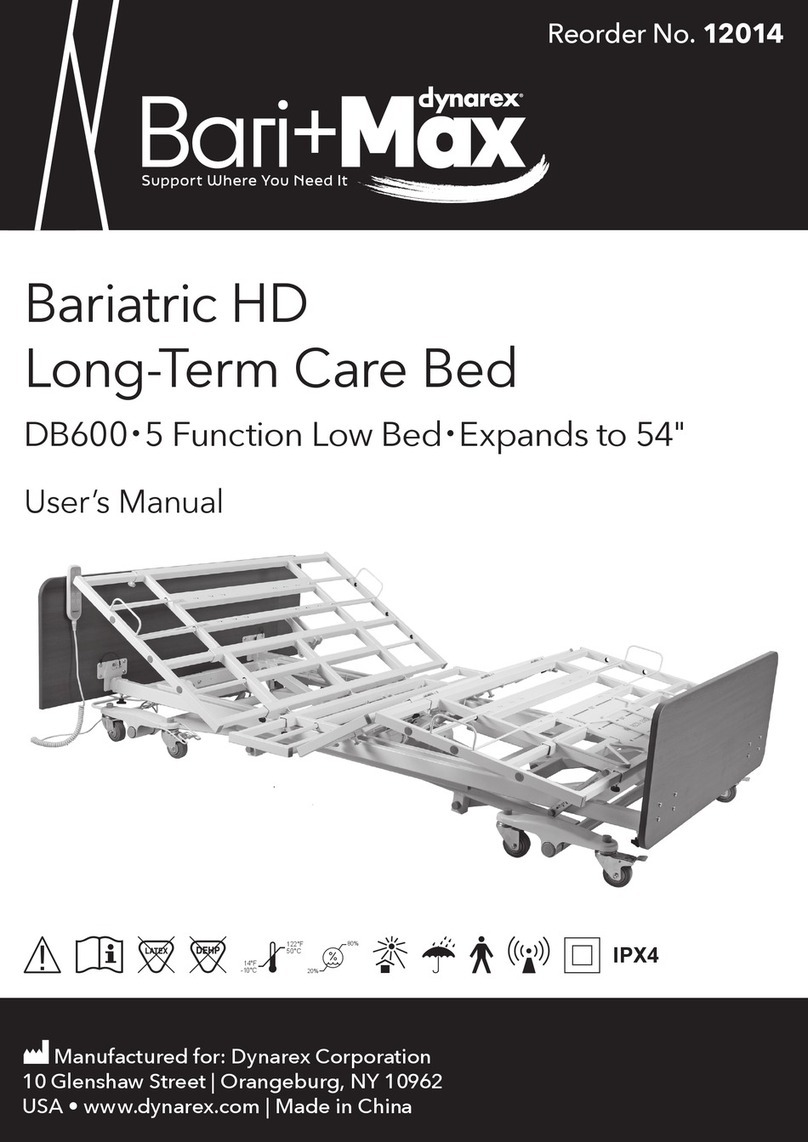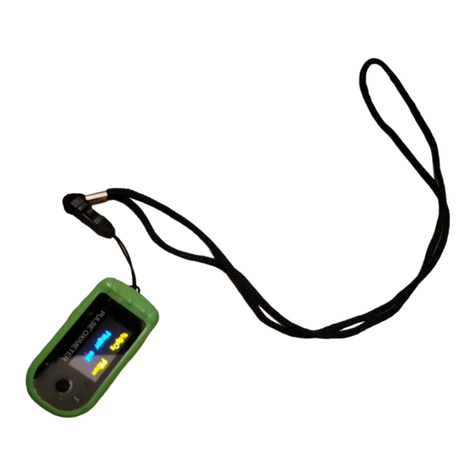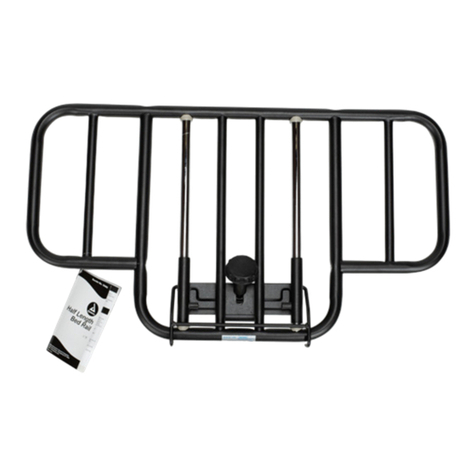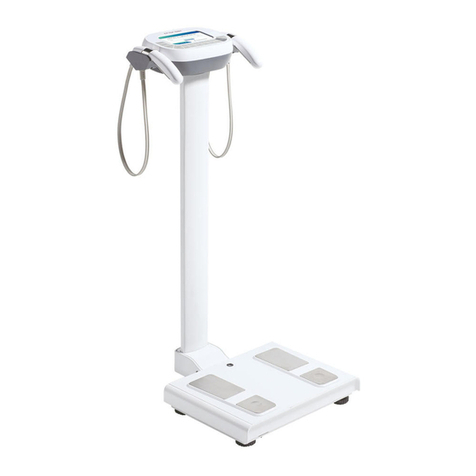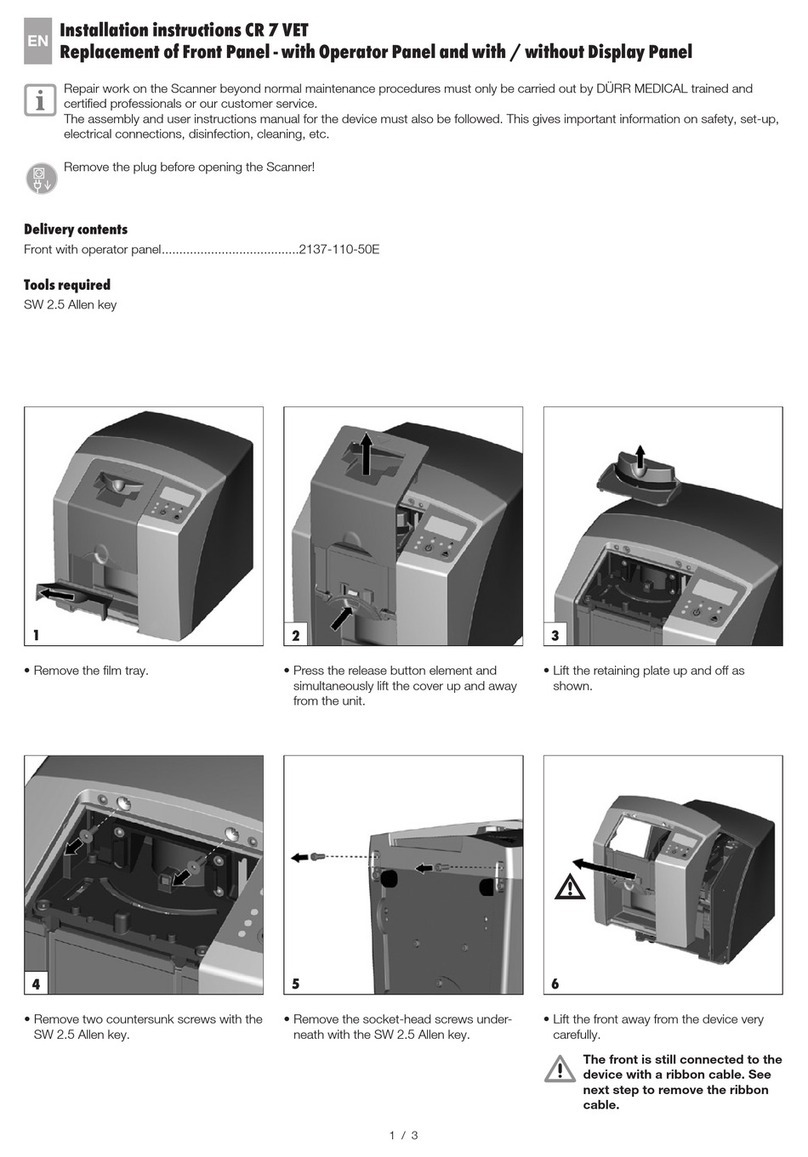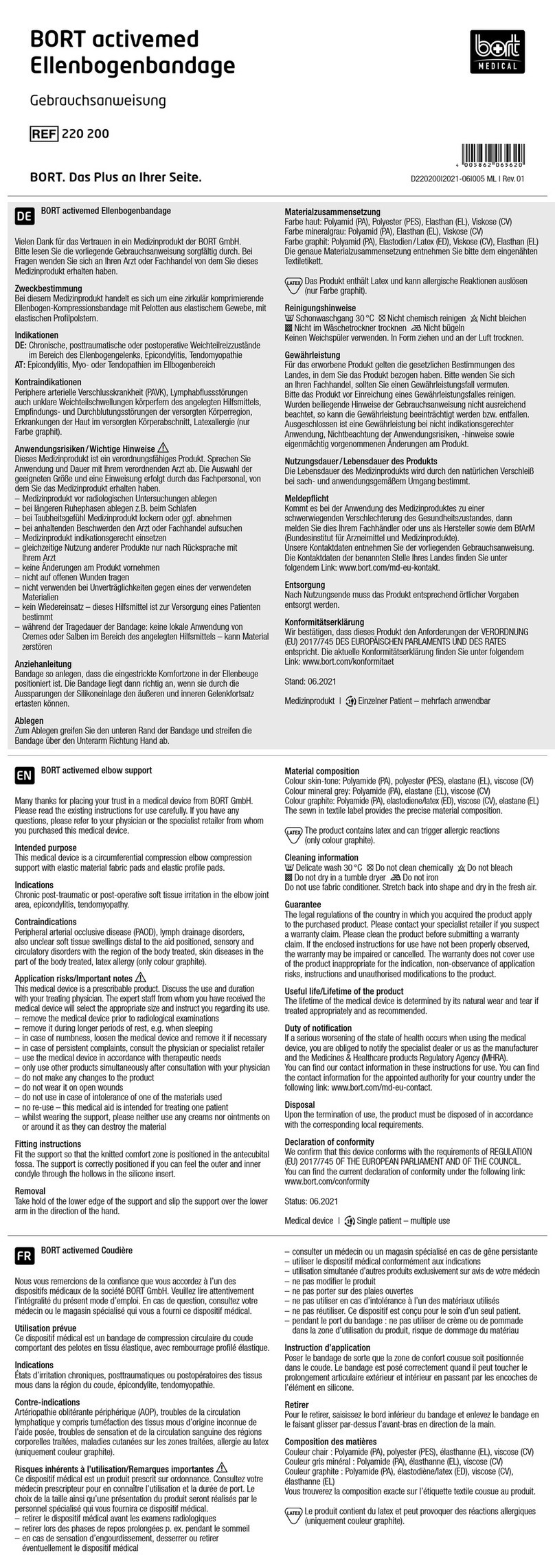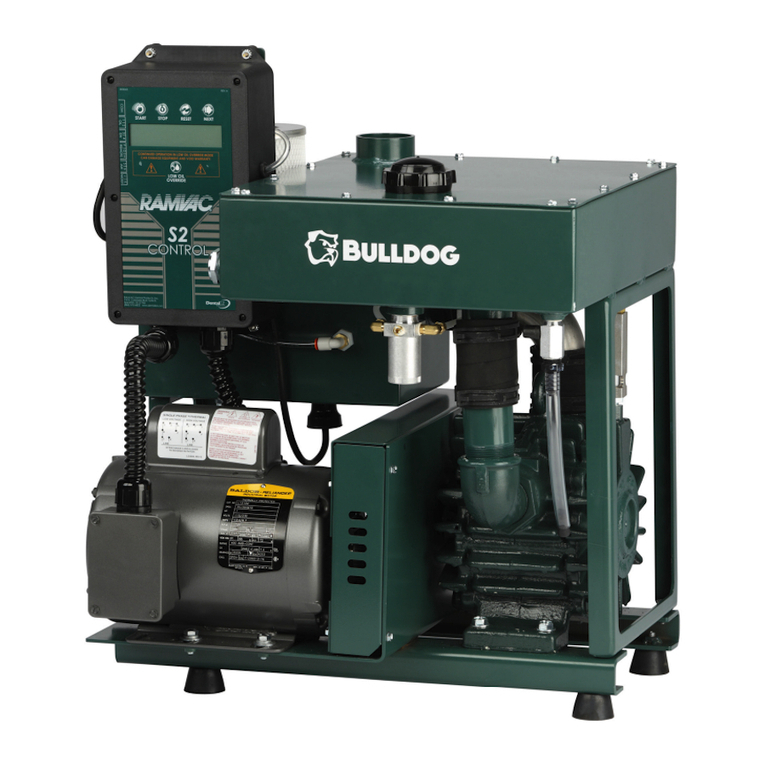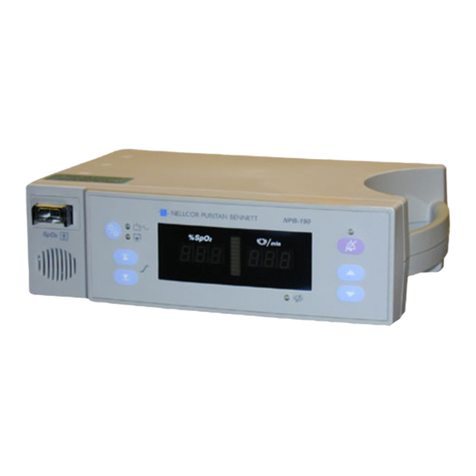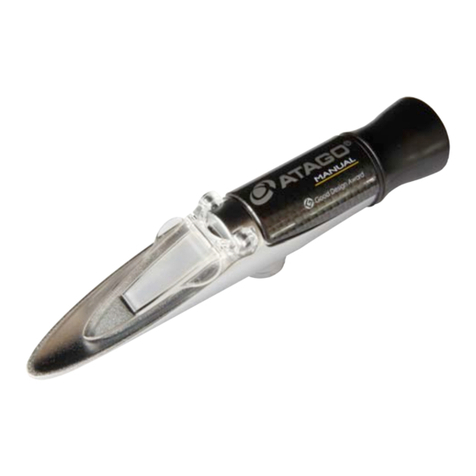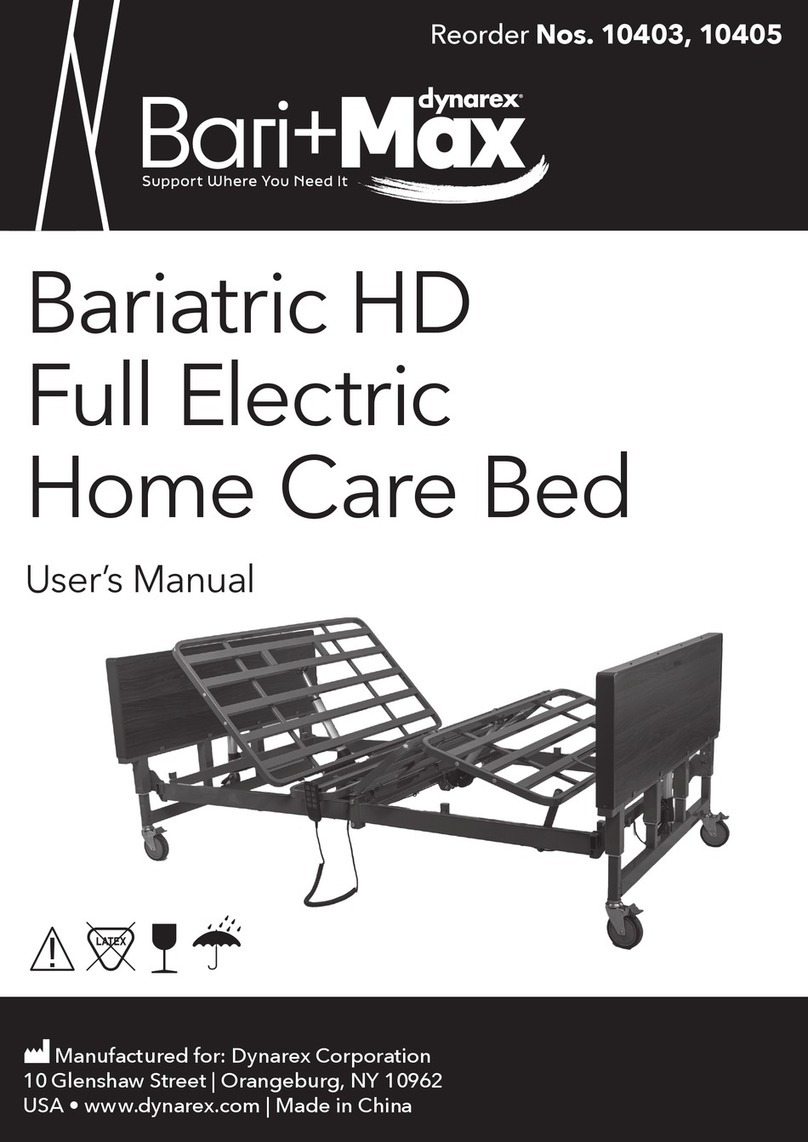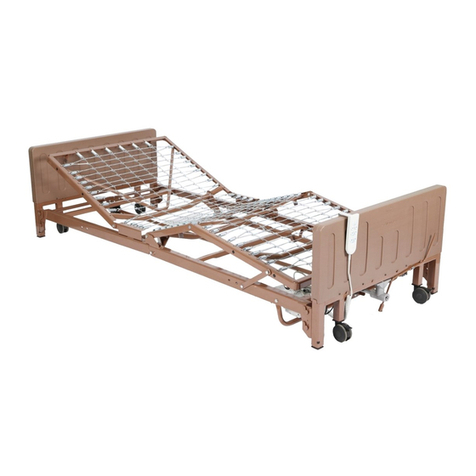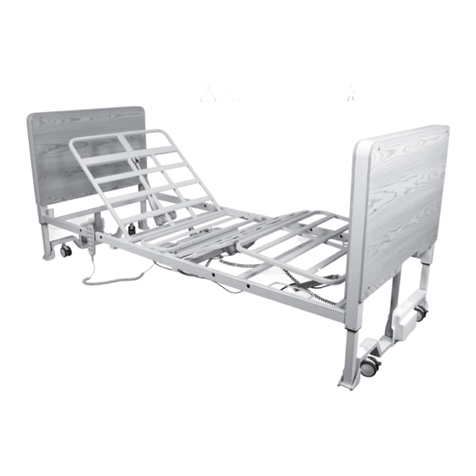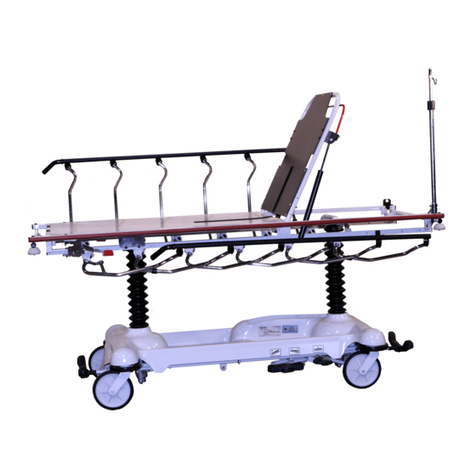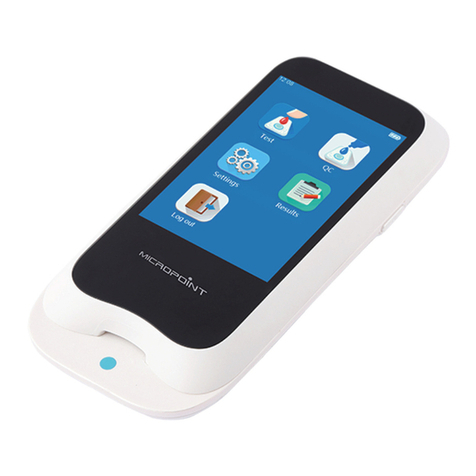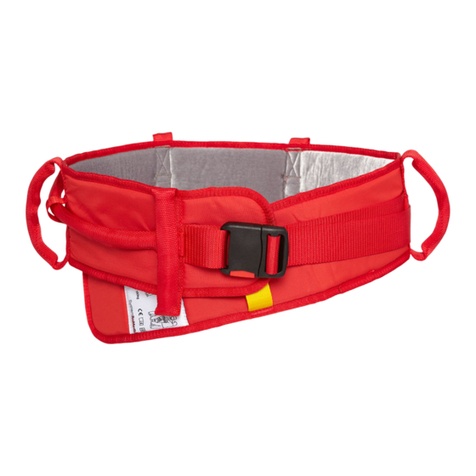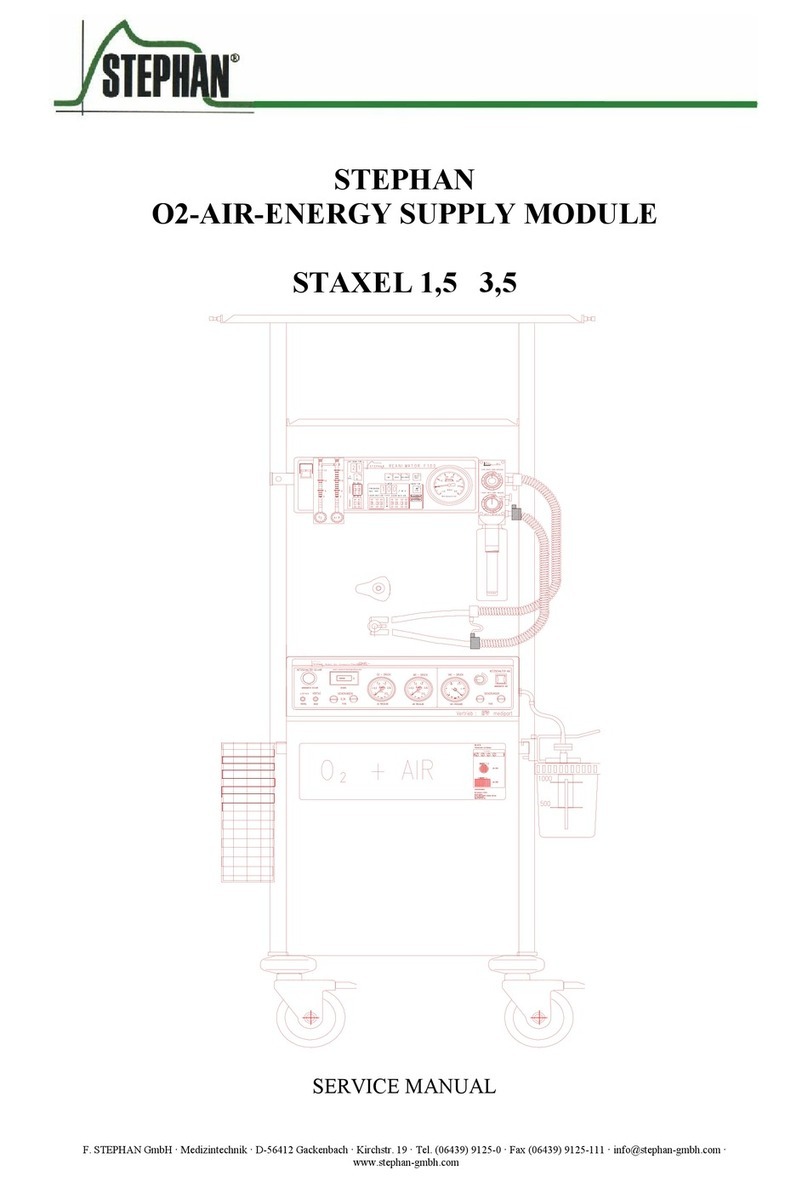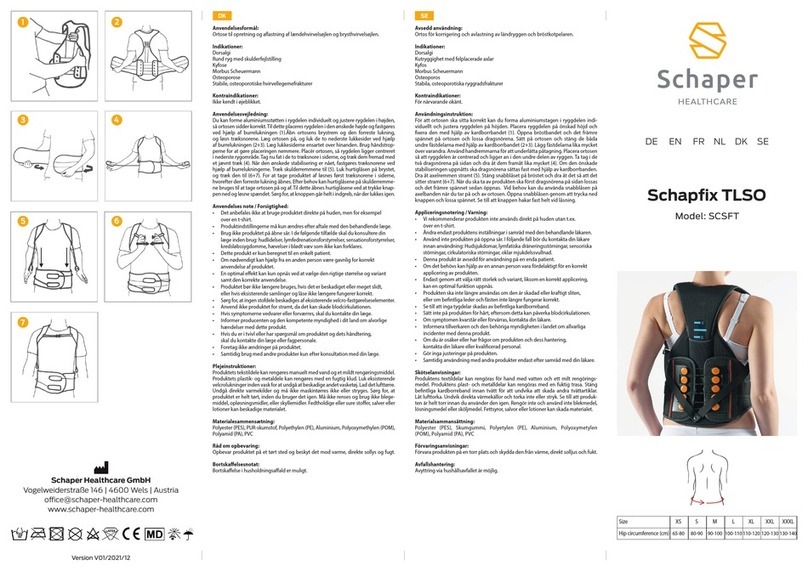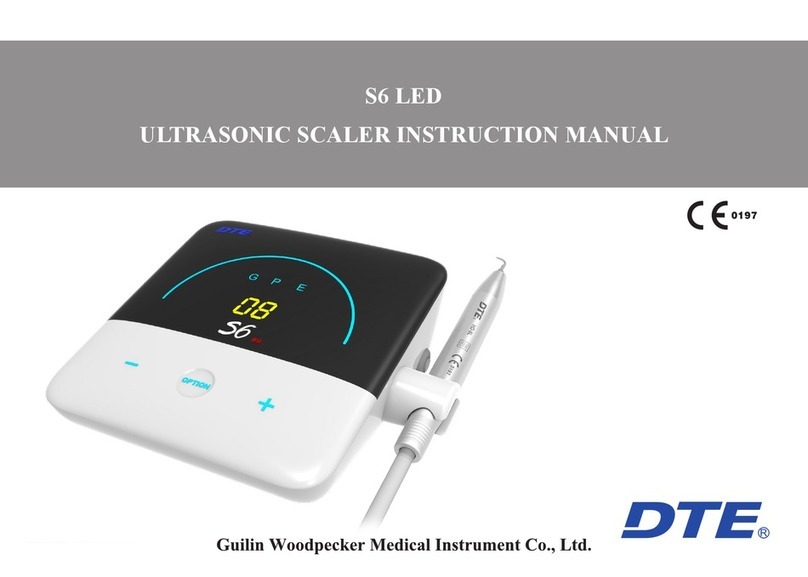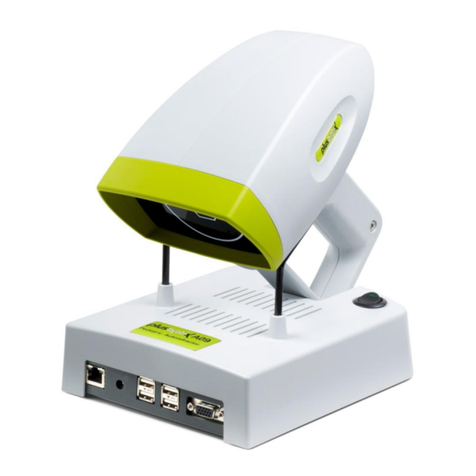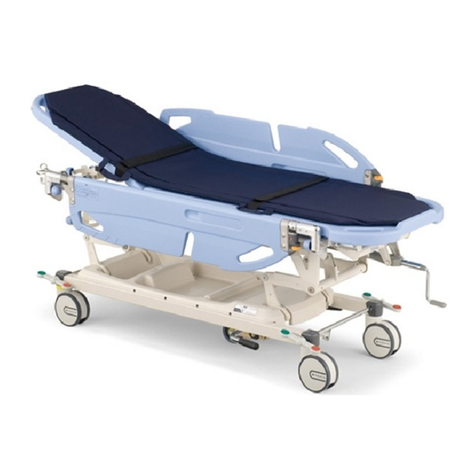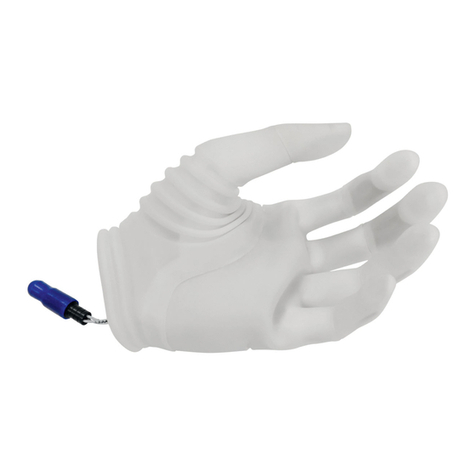
General Description
Oxygen binds to hemoglobin in red blood cells when moving through the lungs. It is transported throughout the body as arterial
blood. A pulse oximeter uses two frequencies of light (red and infrared) to determine the percentage (%) of hemoglobin in the blood
that is saturated with oxygen. The percentage is called blood oxygen saturation, or SpO2. A pulse oximeter also measures and
displays the pulse rate at the same time it measures the SpO2level.
Measurement Principle
Principle of the oximeter is as follows: The pulse oximeter works by applying a sensor to a pulsating arteriolar vascular bed. The
sensor contains a dual light source and photo detector. The one wavelength of light source is 660nm, which is red light; the other is
905nm, which is infrared-red light. Skin, bone, tissue and venous vessels normally absorb a constant amount of light over time. The
photo detector in finger sensor collects and converts the light into electronic signal which is proportional to the light intensity. The
arteriolar bed normally pulsates and absorbs variable amounts of light during systole and diastole, as blood volume increases and
decreases. The ratio of light absorbed at systole and diastole is translated into an oxygen saturation measurement. This
measurement is referred to as SpO2.
Diagram of Operation Principle
1. Red and Infrared-ray Emission Tube
2. Red and Infrared-ray Receipt Tube
Precautions For Use
1.Before use, carefully read the manual.
2.Operation of the fingertip pulse oximeter may be affected by the use of an electrosurgical unit (ESU).
3.The fingertip pulse oximeter must be able to measure the pulse properly to obtain an accurate SpO2measurement. Verify that
nothing is hindering the pulse measurement before relying on the SpO2measurement.
4.Do not use the fingertip pulse oximeter in an MRI or CT environment.
5.Do not use the fingertip pulse oximeter in situations where alarms are required. The device has no alarms. It is not for
continuous monitoring.
6.Do not use the fingertip pulse oximeter in an explosive atmosphere.
7.The fingertip pulse oximeter is intended only as an adjunct in patient assessment. It must be used in conjunction with other
methods of assessing clinical signs and symptoms.
8.In order to ensure correct sensor alignment and skin integrity, the maximum application time at a single site for our device
should be less than half an hour.
9.Do not sterilize the device using autoclaving, ethylene oxide sterilizing, or immersing the device in liquid. The device is not
intended for sterilization.
10.Follow local ordinances and recycling instructions regarding disposal or recycling of the device and device components,
including batteries.
11.This equipment complies with IEC 60601-1-2:2014 for electromagnetic compatibility for medical electrical equipment and/or
systems. However, because of the proliferation of radio-frequency transmitting equipment and other sources of electrical noise in
healthcare and other environments, it is possible that high levels of such interference due to close proximity or strength of a source
might disrupt the performance of this device.
12.Portable and mobile RF communications equipment can affect medical electrical equipment
13.This equipment is not intended for use during patient transport outside the healthcare facility.
14.This equipment should not be used adjacent to or stacked with other equipment.
15.It may be unsafe to:
—use accessories、detachable parts and materials not described in the instructions for use
—interconnect this equipment with other equipment not described in the instructions for use
—disassemble, repair or modify the equipment
16.These materials that contact with the patient’s skin contain medical silicone and ABS plastic enclosure are all pass the
ISO10993-5 Tests for invitro cytotoxicity and ISO10993-10 Tests for irritation and delayed-type hypersensitivity.
17.When the signal is not stable, the reading may inaccurate. Please do not reference.
Rx only: “Caution: Federal law (USA) restricts this device to sale by or on the order of a licensed practitioner.”
Contraindication
Not yet found.
Inaccurate measurements may be caused by
1. Significant levels of dysfunctional hemoglobin (such as carbonyl - hemoglobin or methemoglobin).
2. Intravascular dyes such as indocyanine green or methylene blue.
3. High ambient light. Shield the sensor area if necessary.
4. Excessive patient movement.
5. High-frequency electrosurgical interference and defibrillators.
6. Venous pulsations.
7. Placement of a sensor on an extremity with a blood pressure cuff, arterial catheter, or intravascular line.
8. The patient has hypotension, severe vasoconstriction, severe anemia, or hypothermia.
9. The patient is in cardiac arrest or is in shock.
10. Fingernail polish or false fingernails.
11. Weak pulse quality (low perfusion).
12. Low hemoglobin.
Product Features
1. Simple to operate and convenient to carry.
2. Small volume, light weight and low power consumption.
3. Dual color OLED displays SpO2, PR, Pulse bar, and waveform.
4. Level 1-10 adjustable brightness.
5. 6 display modes.
6. 2pcs AAA-size alkaline batteries; battery-low indicator.
7. When it shows "Finger out", the pulse oximeter will power off automatically in 8 seconds.
Intended Use
The Fingertip Pulse Oximeter is a handheld non-invasive device intended for spot-checking of oxygen saturation of arterial
hemoglobin (SpO2) and Pulse Rate of adult, adolescent and child patients in hospitals, hospital-type facilities and homecare.
Operation Instructions
1. Install two AAA batteries according to the Battery Installation instructions.
2. Place one of your fingers into the rubber opening of the pulse oximeter.
3. Press the switch button one time on front panel to turn the pulse oximeter on.
4. Keep your hands still for the reading. Do not shake your finger during the test. It is recommended that you do not move your
body while taking a reading.
5. Read the data from the display screen
6. Press the power switch for longer than one second, will adjust the brightness of the oximeter. There are 10 levels of brightness.
The default is level four.
After turning on the Oximeter, each time you press the power switch, the Oximeter will switch to another display mode.
There are 6 display modes shown as follows:
1. 2. 3. 4. 5. 6.
Front Panel
Note:
1. If the screen display “?”, it means the signal is unstable, please keep your hands still and retry.
2. The pulse bar less than 30% indicates signal inadequacy and the displayed SpO2and pulse rate value is potentially incorrect.
Battery Installation
1. Install two AAA batteries into the battery compartment. Match the plus (+) and minus (-) signs in the compartment. If the
polarities are not matched, damage may be caused to the oximeter.
2. Slide the battery door cover horizontally along the arrow shown as the picture.
Notes:
Please remove the batteries if the pulse oximeter will not be used for long periods of time.
Please replace the battery when the power indicator starting flickering.
Using the Lanyard
1. Thread thinner end of the lanyard through the hanging hole.
2. Thread thicker end of the lanyard through the threaded end before pulling it tightly.
Warnings!
Keep the oximeter away from young children. Small items such as the battery door, battery, and lanyard are choking hazards.
Do not hang the lanyard from the device’s electrical wire.
Please notice that the lanyard which is tied to the oximeter may cause strangulation due to excessive length.
Maintenance and Storage
1. Replace the batteries in a timely manner when low voltage lamp is lighted.
2. Clean surface of the fingertip oximeter before it is used in diagnosis for patients.
3. Remove the batteries if the oximeter is not operated for a long time.
4. It is best to store the product in -25℃~+70℃and ≤93% humidity.
5. Keep in a dry place. Extreme moisture may affect oximeter lifetime and may cause damage.
6. Dispose of battery properly; follow any applicable local battery disposal laws.
Cleaning the fingertip pulse oximeter
Please use medical alcohol to clean the silicone touching the finger inside of oximeter with a soft cloth dampened with 70%
isopropyl alcohol. Also clean the being tested finger using alcohol before and after each test.
Do not pour or spray liquids onto the oximeter, and do not allow any liquid to enter any openings in the device. Allow the oximeter to
dry thoroughly before reuse.
The fingertip pulse oximeter requires no routine calibration or maintenance other than replacement of batteries.
The use life of the device is five years when it is used for 15 measurements every day and 10 minutes per one
measurement. Stop using and contact local service center if one of the following cases occurs:
An error in the Possible Problems and solutions is displayed on screen.
The oximeter cannot be powered on in any case and not the reasons of battery.
There is a crack on the oximeter or damage on the display resulting readings cannot be identified; the spring is invalid; or the
key is unresponsive or unavailable.
Disinfecting
The applied parts touching the patients’ body are required to be disinfected once after each use. The recommended disinfectants
include: ethanol 70%, isopropanol 70%, glutaraldehyde-type 2% liquid disinfectants.
Disinfection may cause damage to the equipment and is therefore not recommended for this pulse oximeter unless otherwise
indicated in your hospital’s servicing schedule. Clean the pulse oximeter before disinfecting it.
CAUTION: Never use EtO or formaldehyde for disinfection.
Specifications
1. Display Type
OLED display
2. SpO2
Display range: 0%~100%
Measurement range: 70%~100%
Accuracy: 70%~100%±2%; 0%~69% no definition
Resolution: 1%
Note:A functional tester cannot be used to assess the accuracy of a pulse oximeter monitor or sensor. Clinical testing is used to
establish the SpO2accuracy. The measured arterial hemoglobin saturation value (SpO2) of the sensors is compared to arterial
hemoglobin oxygen (SaO2) value, determined from blood samples with a laboratory CO-oximeter. The accuracy of the sensors in
comparison to the CO-oximeter samples measured over the SpO2range of 70%~100%. Accuracy data is calculated using the
root-mean-squared (Arms value) for all subjects, per ISO 80601-2-61, Medical Electrical Equipment–Particular requirements for the
basic safety and essential performance of pulse oximeter equipment for medical use.
A functional tester is used to measure how accurately Fingertip Pulse Oximeter is reproducing the specified calibration curve and
the PR accuracy.
The model of functional tester is Index2 FLUKE simulator and the version is 2.1.3.
3. Pulse Rate
Display range: 0bpm~250bpm
Measure range: 30bpm~250bpm
Accuracy: 30bpm~99bpm, ±2bpm; 100bpm~250bpm, ±2%
Resolution: 1bpm
4. Probe LED Specifications
±
±
NOTE: The information about wavelength range can be especially useful to clinicians.
5. Power Requirements
Two AAA alkaline Batteries
Power consumption: Less than 40mA
6. Environment Requirements
Operation Temperature: 5ºC~40ºC
Storage Temperature: -25ºC~+70ºC
Ambient Humidity: 15%~93% no condensation in operation; ≤93% no condensation in storage/transport
Atmosphere pressure: 70kPa~106kPa
Fingertip Pulse Oximeter
Reorder No. 36400


